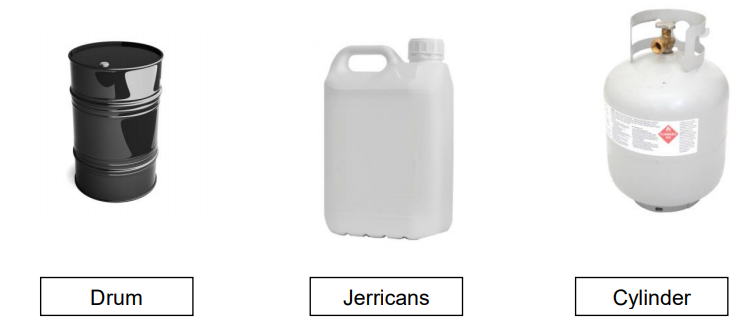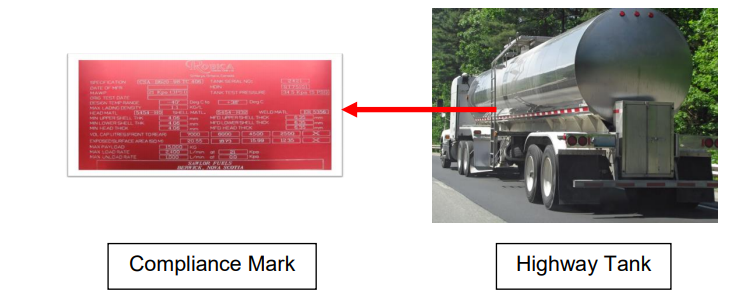This bulletin explains the Means of Containment requirements. It does not change, create, amend or suggest deviations to the Transportation of Dangerous Goods (TDG) Regulations. For specific details, consult Part 5 of the TDG Regulations.
On this page
- Overview
- Means of containment (small and large)
- The selection of a means of containment for dangerous goods
- Manufacture, selection and use of means of containment
- The compliance marks on a means of containment
- Mode of transport/destination
- Compliance with the Transportation of Dangerous Goods Act and Regulations
Overview
The Transportation of Dangerous Goods (TDG) Act, Regulations and standards require dangerous goods to be contained in a safe means of containment. A safe means of containment is designed to prevent the release of dangerous goods that could constitute a danger to life, health, property or the environment under normal conditions of transport. A means of containment is a container or packaging, or any part of a means of transport that is, or may be used, to contain goods.
The TDG Regulations may refer to other regulations or standards for the manufacturing, selection and use of a means of containment for dangerous goods.
Regulations, safety standards and safety requirements may be specific to a class of dangerous goods, means of containment or mode of transport.
This bulletin identifies the types of means of containment used for dangerous goods; assists in the selection of a means of containment; describes the certification safety marks and makes reference to other regulations based on the mode of transport chosen and the destination of the shipment.
Means of containment (small and large)
Small means of containment are containers with a water capacity of 450L or less. They may be drums, jerricans, boxes, pails, bags, barrels, cylinders or intermediate bulk containers (IBC).
Large means of containment are containers with a water capacity greater than 450L. They may be highway tanks, tank cars, intermediate bulk containers (IBC), portable tanks or tubes.
The selection of a means of containment for dangerous goods
Several factors influence the selection of a means of containment, such as:
- class and packing group of the dangerous goods
- type and size of the means of containment
- mode of transport
- destination
Manufacture, selection and use of means of containment
The following table summarizes the requirements of Part 5 (Means of Containment) of the TDG Regulations for the manufacturing, selection and use of a means of containment. With the factors listed above, this table will determine the applicable standard or regulation for the means of containment selected. The table refers to the safety standards short form title. For the complete title, please refer to the table found in Section 1.3.1 of the TDG Regulations.
| Class(es) of dangerous goods | Means of containment | Mode of transport | Applicable standard or regulation |
|---|---|---|---|
| 1 | any | road/rail/marine | CGSB-43.151 |
| air | CGSB-43.151 & Part 12 of the TDG Regulations | ||
| 2 | cylinder, sphere and tube | road/rail/marine/air | CSA-B339, CSA-B340, CSA-B341, CSA-B342 & Section 5.10 and Part 12 of the TDG Regulations |
| aerosol container | road/rail/marine | CGSB-43.123 | |
| air | CGSB-43.123 & Part 12 of the TDG Regulations | ||
| highway tank | road/marine | CSA-B620 & CSA-B622 | |
| tank car and ton containers | road/rail/marine | TP14877 | |
| portable tank | road | CSA-B620, CSA-B622 & CSA-B625 | |
| rail | CSA-B620, CSA-B622 & CSA-B625 | ||
| marine | CSA-B620, CSA-B622 & CSA-B625, Part 11 of the TDG Regulations | ||
| 3, 4, 5, 6.1, 8 & 9 | small packaging | road/rail/marine | TP14850 |
| air | Part 12 of the TDG Regulations | ||
| highway tank | road/marine | CSA-B620 & CSA-B621 | |
| tank car | rail/marine | TP14877 | |
| ton containers | road/rail/marine | TP14877 | |
| portable tank | road | CSA-B620, CSA-B621, CSA-B625 & CSA-B626 | |
| rail/marine | CSA-B620, CSA-B621, CSA-B625 & CSA-B626 | ||
| air | Part 12 of the TDG Regulations | ||
| intermediate bulk container (IBC) |
road/rail/marine | CGSB-43.146 | |
| air | Part 12 of the TDG Regulations | ||
| 6.2 | any | road/rail/marine | CGSB-43.125 |
| air | Part 12 of the TDG Regulations | ||
| 7 | any | road/rail/marine | Packaging and Transport of Nuclear Substances Regulations |
| air | Packaging and Transport of Nuclear Substances Regulations & Part 12 of the TDG Regulations |
Note: For Part 12 and Part 11 of the TDG Regulations please refer to the Mode of Transport/ Destination below
The compliance marks on a means of containment
All standardized means of containment bear compliance marks to indicate that they were manufactured in compliance with a standard. A compliance mark is any symbol, device, letter, word, number or abbreviation that is displayed on a means of containment or means of transport to indicate compliance with a safety standard.
To remain in standard, some means of containment must be periodically inspected, tested and marked at intervals specified by the standard or regulation. These marks describe what, when and by whom the inspections and tests were performed.
All compliance marks must be durable, visible, legible and easily accessible for inspection.
Most means of containment (MOC) standards in Canada are based on the United Nations (UN) Recommendations. UN standardized MOC are internationally recognized and can be used anywhere in the world and by any mode of transport. However, some MOC standards are specific to Canada. Cylinders, tubes, highway tanks, some portable tanks and rail tank cars are examples of such “TC” standardized MOC which will display the “TC” marking. Note that MOC manufactured in the United States bearing the “DOT” certification safety mark may be recognized in Canada under certain conditions.
Mode of transport/destination
There may be additional packaging requirements based on the mode of transport or destination. Refer to the appropriate regulation for more information.
For domestic and international air transport, Part 12 of the TDG Regulations must be consulted for applicable requirements.
For marine transport, Part 11 of the TDG Regulations must be consulted.
The Code of Federal Regulations, Title 49 (49 CFR) must be consulted for road and rail shipments originating from the United States. For road and rail shipments leaving Canada, you must comply with the TDG Regulations.
This bulletin provides a general outline of the means of containment requirements. For specific information, the TDG Act, Regulations and/or standards must be consulted.
Compliance with the Transportation of Dangerous Goods Act and Regulations
Failure to comply with the TDG Act and TDG Regulations may lead to fines and/or imprisonment. For more information, you can visit the TDG website. If you have any questions about the TDG Regulations, contact a Transport Canada dangerous goods inspector in your region.
Atlantic
1-866-814-1477
TDG-TMDAtlantic@tc.gc.ca
Quebec
1-514-633-3400
TMD-TDG.Quebec@tc.gc.ca
Ontario
1-416-973-1868
TDG-TMDOntario@tc.gc.ca
Prairie & Northern Region
1-888-463-0521
pnrtdg-tmdrpn@tc.gc.ca
Pacific
1-604-666-2955
TDGPacific-TMDPacifique@tc.gc.ca
TDG Bulletin: Means of Containment
(PDF, 330 KB)


